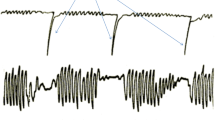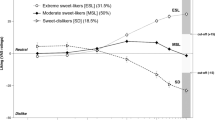Abstract
Background:
People learn about a food's satiating capacity by exposure and consequently adjust their energy intake.
Objective:
To investigate the effect of energy density and texture on subsequent energy intake adjustments during repeated consumption.
Design:
In a randomized crossover design, participants (n=27, age: 21±2.4 years, body mass index: 22.2±1.6 kg m−2) repeatedly consumed highly novel foods that were either low-energy-dense (LE: 30 kcal per 100 g) or high-energy-dense (HE: 130 kcal per 100 g), and either liquid or semi-solid, resulting in four product conditions. In each condition, a fixed portion of test food was consumed nine times as an obligatory part of breakfast, lunch and dinner on 3 consecutive days. All meals continued with an ad libitum buffet; food items for evening consumption were provided and the intake (kcal per day) was measured.
Results:
Buffet intake depended on energy density and day of consumption of the test foods (day*energy interaction: P=0.02); daily buffet intake increased from day 1 (1745±577 kcal) to day 3 (1979±567 kcal) in the LE conditions; intake did not change in the HE conditions (day 1: 1523±429 kcal, day 3: 1589±424 kcal). Food texture did not affect the intake (P=0.56).
Conclusions:
Intake did depend on energy density of the test foods; participants increased their buffet intake over days in response to learning about the satiating capacity of the LE foods, but did not change buffet intake over days when repeatedly consuming a HE food as part of their meal. The adjustments in intake were made irrespective of the food texture.
This is a preview of subscription content, access via your institution
Access options
Subscribe to this journal
Receive 12 print issues and online access
$259.00 per year
only $21.58 per issue
Buy this article
- Purchase on Springer Link
- Instant access to full article PDF
Prices may be subject to local taxes which are calculated during checkout


Similar content being viewed by others
References
Booth DA, Lee M, McAleavey C . Acquired sensory control of satiation in man. Brit J Psychol 1976; 67: 137–147.
Davis JD, Smith GP . The conditioned satiating effect of orosensory stimuli. Physiol Behav 2009; 97: 293–303.
Brunstrom JM . Associative learning and the control of human dietary behavior. Appetite 2007; 49: 268–271.
Booth DA, Mather P, Fuller J . Starch content of ordinary foods associatively conditions human appetite and satiation, indexed by intake and eating pleasantness of starch-paired flavours. Appetite 1982; 3: 163–184.
Louis-Sylvestre J, Tournier A, Verger P, Chabert M, Delorme B, Hossenlopp J . Learned caloric adjustment of human intake. Appetite 1989; 12: 95–103.
Yeomans MR, Weinberg L, James S . Effects of palatability and learned satiety on energy density influences on breakfast intake in humans. Physiol Behav 2005; 86: 487–499.
Zandstra EH, Stubenitsky K, De Graaf C, Mela DJ . Effects of learned flavour cues on short-term regulation of food intake in a realistic setting. Physiol Behav 2002; 75: 83–90.
Van Wymelbeke V, Beridot-Therond ME, de La Gueronniere V, Fantino M . Influence of repeated consumption of beverages containing sucrose or intense sweeteners on food intake. Eur J Clin Nutr 2004; 58: 154–161.
Specter SE, Bellisle F, Hémery-Véron S, Fiquet P, Bornet FRJ, Slama G . Reducing ice cream energy density does not condition decreased acceptance or engender compensation following repeated exposure. Eur J Clin Nutr 1998; 52: 703–710.
Rolls BJ . The relationship between dietary energy density and energy intake. Physiol Behav 2009; 97: 609–615.
Hulshof T, De Graaf C, Weststrate JA . The effects of preloads varying in physical state and fat content on satiety and energy intake. Appetite 1993; 21: 273–286.
Mattes RD, Rothacker D . Beverage viscosity is inversely related to postprandial hunger in humans. Physiol Behav 2001; 74: 551–557.
Mattes RD . Dietary compensation by humans for supplemental energy provided as ethanol or carbohydrate in fluids. Physiol Behav 1996; 59: 179–187.
Zijlstra N, Mars M, de Wijk RA, Westerterp-Plantenga MS, de Graaf C . The effect of viscosity on ad libitum food intake. Int J Obes 2008; 32: 676–683.
Mars M, Hogenkamp PS, Gosses AM, Stafleu A, De Graaf C . Effect of viscosity on learned satiation. Physiol Behav 2009; 98: 60–66.
Hogenkamp PS, Mars M, Stafleu A, de Graaf C . Intake during repeated exposure to low- and high-energy-dense yogurts by different means of consumption. Am J Clin Nutr 2010; 91: 841–847.
Levitsky DA, Obarzanek E, Mrdjenovic G, Strupp BJ . Imprecise control of energy intake: absence of a reduction in food intake following overfeeding in young adults. Physiol Behav 2005; 84: 669–675.
Caputo FA, Mattes RD . Human dietary responses to covert manipulations of energy, fat, and carbohydrate in a midday meal. Am J Clin Nutr 1992; 56: 36–43.
Tarasuk V, Beaton GH . Day-to-day variation in energy and nutrient intake: evidence of individuality in eating behaviour? Appetite 1992; 18: 43–54.
Van Strien T . Nederlandse Vragenlijst voor Eetgedrag (NVE). Handleiding [Dutch Eating Behaviour Questionnaire. Manual]. Boom Test Publishers: Amsterdam, The Netherlands, 2005.
WHO. Estimates of energy and protein requirements of adults and children. Energy and Protein Requirements. Report of a Joint FAO/WHO/UNU Expert Consultation, 2nd edn. World Health Organization: Geneva, 1985, pp. 71–112.
Brunstrom JM, Shakeshaft NG, Scott-Samuel NE . Measuring ‘expected satiety’ in a range of common foods using a method of constant stimuli. Appetite 2008; 51: 604–614.
de Castro JM . Dietary energy density is associated with increased intake in free-living humans. J Nutr 2004; 134: 335–341.
Bell EA, Castellanos VH, Pelkman CL, Thorwart ML, Rolls BJ . Energy density of foods affects energy intake in normal-weight women. Am J Clin Nutr 1998; 67: 412–420.
Blatt AD, Roe LS, Rolls BJ . Hidden vegetables: an effective strategy to reduce energy intake and increase vegetable intake in adults. Am J Clin Nutr 2011; 93: 756–763.
Brunstrom JM, Shakeshaft NG, Alexander E . Familiarity changes expectations about fullness. Appetite 2010; 54: 587–590.
Appleton KM, Martins C, Morgan LM . Age and experience predict accurate short-term energy compensation in adults. Appetite 2011; 56: 602–606.
Poppitt SD, Prentice AM . Energy density and its role in the control of food intake: evidence from metabolic and community studies. Appetite 1996; 26: 153–174.
Hall KD, Sacks G, Chandramohan D, Chow CC, Wang YC, Gortmaker SL et al. Quantification of the effect of energy imbalance on bodyweight. Lancet 2011; 378: 826–837.
Campbell RG, Hashim SA, Van Itallie TB . Studies of food-intake regulation in man. Responses to variations in nutritive density in lean and obese subjects. N Engl J Med 1971; 285: 1402–1407.
Ebbeling CB, Sinclair KB, Pereira MA, Garcia-Lago E, Feldman HA, Ludwig DS . Compensation for energy intake from fast food among overweight and lean adolescents. JAMA 2004; 291: 2828–2833.
Carnell S, Gibson C, Benson L, Ochner CN, Geliebter A . Neuroimaging and obesity: current knowledge and future directions. Obes Rev 2011; epub ahead of print 8 September 2011.
De Castro JM, McCormick J, Pedersen M, Kreitzman SN . Spontaneous human meal patterns are related to preprandial factors regardless of natural environmental constraints. Physiol Behav 1986; 38: 25–29.
Hogenkamp PS, Stafleu A, Mars M, Brunstrom JM, de Graaf C . Texture, not flavor, determines expected satiation of dairy products. Appetite 2011; 57: 635–641.
Weijzen PL, Liem DG, Zandstra EH, de Graaf C . Sensory specific satiety and intake: the difference between nibble- and bar-size snacks. Appetite 2008; 50: 435–442.
Almiron-Roig E, Chen Y, Drewnowski A . Liquid calories and the failure of satiety: how good is the evidence? Obes Rev 2003; 4: 201–212.
Acknowledgements
We thank all participants, and Celine Brattinga, Ingrid Heemels, Rudolf van der Helm, Marja Kanning, Dorthe Klein, Els Siebelink, Cecile Spoorenberg and Merel van Veen for their help in carrying out the study. This work was supported by the TI Food and Nutrition.
Author information
Authors and Affiliations
Corresponding author
Ethics declarations
Competing interests
The authors declare no conflict of interest.
Appendix
Appendix
Rights and permissions
About this article
Cite this article
Hogenkamp, P., Stafleu, A., Mars, M. et al. Learning about the energy density of liquid and semi-solid foods. Int J Obes 36, 1229–1235 (2012). https://doi.org/10.1038/ijo.2011.231
Received:
Revised:
Accepted:
Published:
Issue Date:
DOI: https://doi.org/10.1038/ijo.2011.231
Keywords
This article is cited by
-
Impact of energy density on energy intake in children and adults: a systematic review and meta-analysis of randomized controlled trials
European Journal of Nutrition (2023)
-
Food texture influences on satiety: systematic review and meta-analysis
Scientific Reports (2020)
-
Does low-energy sweetener consumption affect energy intake and body weight? A systematic review, including meta-analyses, of the evidence from human and animal studies
International Journal of Obesity (2016)



